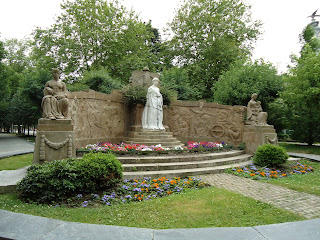 Kaixo, everybody. This is my last post for this blog. My train leaves Donostia tomorrow morning at 6:36. I thought I would end my blog with a glimpse of the surrounding countryside, especially the gorgeous Basque Country coast. Yesterday morning, I went to the fortified Renaissance city of Hondarribia, formerly known as Fuenterrabia but which has reverted back to its original Basque name. It´s the only town left in Gipuzkoa that still has its old fortifications.
Kaixo, everybody. This is my last post for this blog. My train leaves Donostia tomorrow morning at 6:36. I thought I would end my blog with a glimpse of the surrounding countryside, especially the gorgeous Basque Country coast. Yesterday morning, I went to the fortified Renaissance city of Hondarribia, formerly known as Fuenterrabia but which has reverted back to its original Basque name. It´s the only town left in Gipuzkoa that still has its old fortifications. Occupying a key position on the Spanish/French border, it has seen much history. Holy Roman Emperor and Spanish King Carlos V began fortifying it in the 16th century.
Occupying a key position on the Spanish/French border, it has seen much history. Holy Roman Emperor and Spanish King Carlos V began fortifying it in the 16th century. Within the thick walls and ramparts are lovely, sloping streets with beautiful houses.
Within the thick walls and ramparts are lovely, sloping streets with beautiful houses. This house built during the Renaissance is now a music school.
This house built during the Renaissance is now a music school. Some of the "newer" houses look oddly like Swiss chalets. Balcony after balcony is bursting with geraniums.
Some of the "newer" houses look oddly like Swiss chalets. Balcony after balcony is bursting with geraniums. Earlier this week, I took the short bus ride (you can also take a three-hour coastal hike) to Passajes, which is essentially one town with four distinct parts. The most celebrated and the one which draws tourists is the section you see behind me, San Juan or Donibani in Basque. To reach it, you need to take the bus to San Pedro across the river and then board a boat.
Earlier this week, I took the short bus ride (you can also take a three-hour coastal hike) to Passajes, which is essentially one town with four distinct parts. The most celebrated and the one which draws tourists is the section you see behind me, San Juan or Donibani in Basque. To reach it, you need to take the bus to San Pedro across the river and then board a boat. A single road runs through San Juan and continues to the river´s mouth and the ocean.
A single road runs through San Juan and continues to the river´s mouth and the ocean. Victor Hugo came here in 1843 and wrote in detail about the beauty of the landscape and the peculiar nature of the town and of Basque houses. The house where he stayed is now a gem of a museum and you can listen to his words in either Basque, Spanish, French or English. After seeing this beautiful town, it was especially moving to hear my own impressions so beautifully and inimitably expressed by Hugo as I poked around the few rooms he occupied.
Victor Hugo came here in 1843 and wrote in detail about the beauty of the landscape and the peculiar nature of the town and of Basque houses. The house where he stayed is now a gem of a museum and you can listen to his words in either Basque, Spanish, French or English. After seeing this beautiful town, it was especially moving to hear my own impressions so beautifully and inimitably expressed by Hugo as I poked around the few rooms he occupied. The inhabitants live in houses that are stacked on the hill which rises above the street and which can be reached by a zig-zagging series of stairways and pathways.
The inhabitants live in houses that are stacked on the hill which rises above the street and which can be reached by a zig-zagging series of stairways and pathways.
 Three regional symbols are here on the wall behind this church and children´s school: the sun, the lau buru each leaf of which stands for one of the four Spanish Basque provinces (Gipuzkoa, Nafaroa, Alaba and Bizkaia) and a shell which means that this town is on the pilgrimage route of Santiago de Compostela.
Three regional symbols are here on the wall behind this church and children´s school: the sun, the lau buru each leaf of which stands for one of the four Spanish Basque provinces (Gipuzkoa, Nafaroa, Alaba and Bizkaia) and a shell which means that this town is on the pilgrimage route of Santiago de Compostela.Eskerrik asko (thank you) to all who´ve kept up with my blog and...
...agur (good-bye).











































